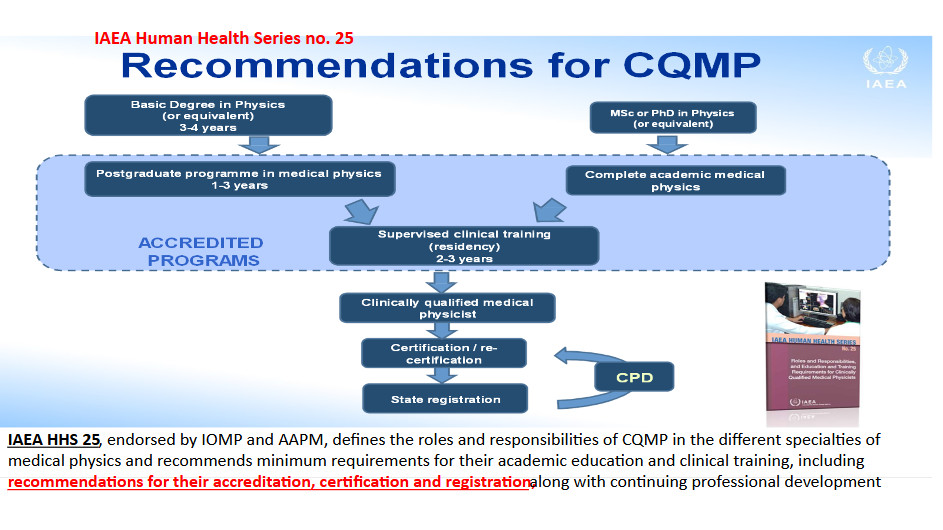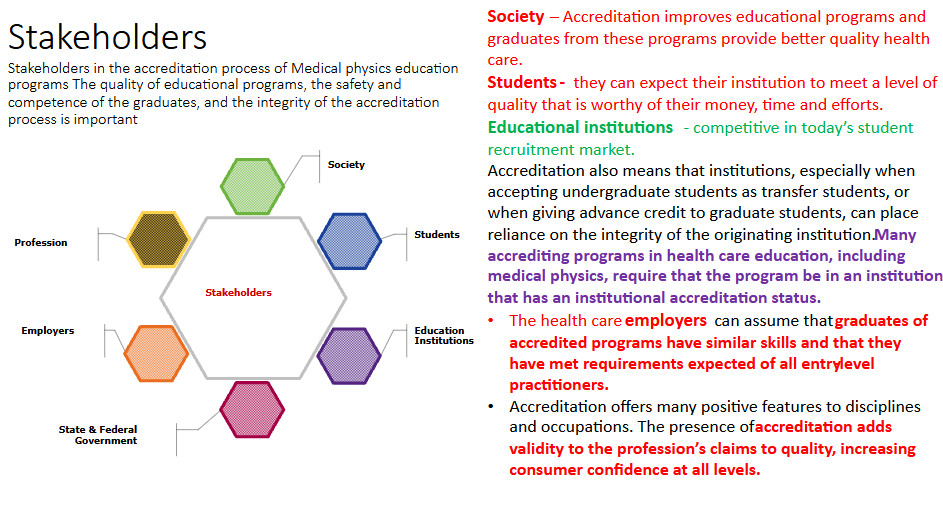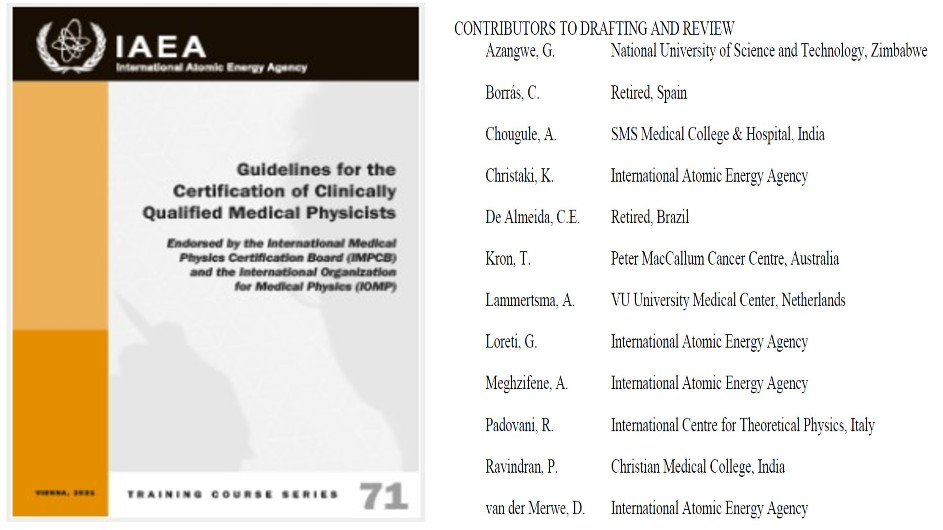Prof. Arun Chougule
Chair ETC IOMP
Chairman IOMP Accreditation Board
Member Board of Directors IMPCB
Immediate past President AFOMP
arunchougule11@gmail.com
Dr. Mary Joan
Chair PRC-AFOMP,
Member SC-IOMP
“Education is not the learning of facts, but the training of the mind to think.”
Albert Einstein
Medical physics is a dynamic field that plays a vital role in the convergence of medicine and technology. The field of Medical Physics is growing rapidly and requires a high degree of knowledge and professional competency owing to the rise in complexity of treatment procedures, increasing access to medical technology, and the need for coordination between the disciplines of medicine, physics and biomedical engineering. As modalities specialized in physics-intensive procedures such as particle therapy, image-guided and intra-operative radiotherapy, advanced imaging, and nuclear medicine techniques continues to advance, the quantity of qualified medical physicists needs to be in consonance with the competency needed as many medical physicists work in clinical positions where their work can directly influence the quality of patient care. Further, health care across the world is undergoing a period of rapid transformation because of economical, technological, and regulatory forces and the demand for clinically competent medical physicists is more significant today than ever which brings both great opportunities and great challenges for the discipline of medical physics. To ensure the sustainable and impactful contribution of medical physics to human health, it is integral that the field should meet these challenges head on. To meet the growing demand, it is essential to ensure that medical physics education programs are designed to produce professionals with the knowledge, skills, and practical experience required in clinical settings. To acquire the knowledge, skills, and competency [KSC], medical physicists must undergo structured education program and fulltime residency under an experienced medical physicist from a recognized institution. To prepare medical physicists for the future, education and training should be properly adjusted to include more basic non-physical sciences, particularly biology; more imaging, especially molecular imaging; and more interdisciplinary and translational research components. The outcome of the academic programme is to provide the students with a thorough grounding in medical physics, critical thinking, scientific rigor, and adequate professional ethicswhere the benefit of the patient is at the center of all the activities.
According to IAEA – HHS25 the structure of medical physics education should be,
A clinically qualified medical physicist [CQMP] must have
- A university degree in physics, engineering, or equivalent physical science
- Appropriate academic qualifications in medical physics (or equivalent) at the postgraduate level,
- At least two years (full time equivalent) structured clinical in-service training undertaken in a hospital.

However, for Latin America and Africa region, so as to facilitate to cope up with the grave shortage of CQMP in the region one year fulltime structured clinical residency is enough to be considered clinically qualified Medical Physicist. [African Regional Co-Operative Agreement for Research, Development and Training Related to Nuclear Science and Technology – academic and clinical training programmes and portfolios for the regional training in medical physics, Minimum Requirements for Medical Physics Education in AFRA Member States https://humanhealth.iaea.org/HHW/MedicalPhysics/TheMedicalPhysicist/EducationandTrainingRequirements/Educationalrequirements/Harmonized_syllabus_for_Medical_Physicists_training_in_Africa.pdf] and [Guías de Formación Académica y Entrenamiento Clínico para Físicos Médicos en América Latina- ALFIM- IAEA [Academic Education and Clinical Training Guides for Medical Physicists in Latin America https://humanhealth.iaea.org/HHW/MedicalPhysics/TheMedicalPhysicist/IDMP/2021/Guias_LA_Region_E&T_MedicalPhysics_ARCAL_ALFIM.pdf]
The holder of a university degree in medical physics without the required hospital training cannot be considered clinically qualified Medical Physicist. Further this education and training should be recognized by a national accreditation body.
As per IOMP Policy Statement No. 1 – Medical physicists working in the clinical environment are health professionals [https://www.iomp.org/ wp-content/uploads/2019/02/iomp policy_ statement_no_1.pdf] and IOMP Policy Statement No. 2- prescribes a basic requirements for Education and Training of Medical Physicists https://www.iomp.org/wp–content/uploads/2019/02/iomp_policy_statement_no_2_0.pdf
To cope with the growing demand of medical physicists, many medical education programs are started across the globe. Education and Training committee [ETC] of IOMP has compiled the data on medical physics education programs around the world and at present approximately MORE THAN 390 Medical Physics Undergraduates / Postgraduates and Research programme are available with the distribution in various regions as follows,
ALFIM [ Latin America] – 46 programmes i.e. 0.076 programs/million population
MEFOMP [ Middle east] – 21 programmes i.e. 0.08 programs/million population
AFOMP [ Asia Oceania] – 119 programmes i.e. 0.03 programs/million population
USA – 42 programmes i.e. 0.127 programs/million population
EFOMP [Europe] -105 programmes i.e. 0.141 programs/million population
FAMPO [Africa] – 37 programmes i.e. 0.026 programs/million population
CANADA – 18 programmes i.e. 0.49 programs/million population
The details are available at https://www.iomp.org/education-training-resources/
We find a huge diversity and therefore the task of homogenising the medical Physics education and profession is quite challenging because of heterogeneity in terms of socioeconomic and educational standards. Further there is a big gap in availability of CQMP in various regions and, therefore a great potential to ramp up the structured education and training of medical physicists to cope with the growing need of not only today but also of future.
The foundation of a successful medical physics education program lies in a well-structured curriculum. The curriculum should cover core theoretical concepts, such as radiation physics, radiobiology, and medical imaging, while also incorporating practical applications relevant to clinical practice. Integration of clinical experience through internships or hands-on training is crucial in bridging the gap between theory and real-world scenarios. Given the rapid evolution of medical technologies, educational programs must stay contemporary. Incorporating the latest advancements in medical imaging, radiation therapy, and diagnostic equipment ensures that graduates are well-versed in the state-of-the-art tools they will encounter in clinical practice. Exposure to emerging technologies, such as artificial intelligence and molecular medical imaging further enhances the adaptability of medical physicists in a rapidly changing healthcare landscape.
Interdisciplinary Collaboration: Medical physicists often work collaboratively with clinicians, radiologists, radiation oncologists, nuclear medicine physicians and other healthcare professionals. Therefore, medical physics education programs should emphasize interdisciplinary collaboration, fostering effective communication, leadership and teamwork. This ensures that medical physicists can seamlessly integrate into healthcare teams, contribute to clinical decision-making, and effectively address patient care challenges. The transition from theoretical knowledge to practical application is facilitated through clinical internships and residencies. These hands-on experiences take place in healthcare institutions, enabling students to work alongside experienced professionals, observe clinical workflows, and actively participate in patient care. Clinical training is invaluable in bridging the gap between academic theory and the real-world challenges encountered in healthcare settings. Furthermore, the medical physics education programs should instil a strong sense of responsibility for implementing and maintaining quality control measures, ensuring that medical physicists prioritize the well-being and safety of patients throughout their careers as integral members of healthcare teams, applying their expertise in physics to ensure the safe and effective use of radiation and imaging technologies.
The present question is whether all the medical physicists trained by various universities/ institutions fulfil these expectations? Whether the medical physicists trained by different universities/ institutions are competent enough to discharge the duty of unsupervised clinical medical physicists?
To assess and standardise the medical physics education and profession, IOMP has started accreditation of medical physics education programs. The details about the IOMP accreditation programmes [Manual, program standards, and accredited programs] are available at https://www.iomp.org/accreditation/

Accreditation of medical physics education programs plays a pivotal role in maintaining and enhancing the quality and relevance of these programs. Accreditation is a process by which educational programs undergo rigorous evaluation to ensure that they meet predetermined standards of quality and effectiveness. In the context of medical physics education, accreditation serves as a benchmark, indicating that a program adheres to established criteria, providing students with a robust foundation for their careers. Accreditation sets and upholds standards that define the quality and content of medical physics education programs. These standards cover various aspects, including curriculum design, faculty qualifications, clinical training, and resources, ensuring a comprehensive and well-rounded educational experience. There are many stakeholders and beneficiaries of the accreditation. Accreditation serves as an assurance of quality for students, educators, and the broader healthcare community. Prospective students can confidently choose accredited programs, knowing that they meet health industry-recognized standards. Employers, in turn, can trust that graduates from accredited programs are well-prepared and possess the necessary competencies for their roles as medical physicists. The presence of accreditation adds validity to the profession’s claims to quality, increasing consumer confidence at all levels.

The major advantages of IOMP accreditations are
- Accreditation enhances the global recognition of medical physics education programs
- Graduates from accredited programs are more likely to have their qualifications accepted internationally, fostering mobility and collaboration among professionals across borders.
- Global recognition contributes to the standardization of education and practice, promoting consistency and quality on a global scale
Accreditation is not a one-time achievement but an ongoing commitment to continuous improvement. Accredited programs are expected to engage in self-assessment, regular evaluations, and updates to stay contemporary with evolving educational practices, emerging technologies, and advancements in the field. This commitment ensures that graduates are equipped with the latest knowledge and skills relevant to contemporary healthcare needs.
Accreditation of medical physics education programs is a cornerstone in the pursuit of excellence in the field. By establishing and upholding standards, assuring quality, fostering continuous improvement, gaining global recognition, and aligning with professional certifications, accreditation plays a crucial role in shaping the next generation of competent and highly skilled medical physicists. As the landscape of healthcare evolves, the commitment to accreditation ensures that education programs remain adaptive, relevant, and dedicated to producing professionals who can effectively contribute to the dynamic and ever-changing field of medical physics.
Professional Certification: Medical Physicists are health professionals and therefore to guarantee a high standard of competence, medical physicists should pursue professional certifications, an additional layer of validation for their clinical competence. Certification contributes significantly to the elevation of professional standards within the field of medical physics. By establishing specific criteria and assessments, certification boards ensure that individuals seeking certification possess a comprehensive understanding of the scientific principles, technologies, and ethical considerations essential for their roles. Certification is a means of verifying the competence of medical physicists. It requires candidates to undergo thorough examinations, practical assessments, and evaluations of their education and training. This rigorous process ensures that certified professionals have the necessary skills and knowledge to navigate complex clinical scenarios, make informed decisions, and contribute effectively to patient care. This commitment to excellence strengthens the overall quality of medical physics practice. Certification also promotes ongoing professional development and adherence to ethical standards. Professional certifications are a hallmark of competency in the field of medical physics. Many countries have established certification boards that assess the qualifications and capabilities of aspiring medical physicists. For accreditation of national certification boards and individual certification of medical physicists, International Medical Physics Certification Board [IMPCB] has started accreditation of certification boards and certification of individual medical physicists [https://www.impcbdb.org/]. To help Member States to establish the certification and registration of medical physicists as health professional IAEA has brought out Training Course Series TCS 71 document in 2021 “Guidelines on certification of Clinically Qualified Medical Physicists”, this document is endorsed by IOMP and IMPCB [https://www.iaea.org/publications/14746/guidelines-for-the-certification-of-clinically-qualified-medical-physicists].

Certification for medical physicists involves a rigorous process through which individuals demonstrate their proficiency, knowledge, and adherence to established standards within the field.
Earning certifications demonstrates a commitment to excellence and adherence to established standards, enhancing the credibility and marketability of professionals in the field. Certification offers international recognition of an individual’s qualifications. Certification opens doors to enhanced career opportunities and advancement. Many employers, healthcare institutions, and regulatory bodies prioritize hiring or recognizing medical physicists with certifications from reputable organizations. Certified individuals often have a competitive edge in the job market and are better positioned for leadership roles within their organizations. Certification is a testament to an individual’s commitment to these fundamental principles. Certified medical physicists are more likely to adhere to best practices, implement quality assurance measures, and contribute to a culture of safety, ultimately benefiting the patients they serve. As the healthcare landscape evolves, the certification of medical physicists remains an essential element in ensuring that these professionals contribute effectively to the advancements and challenges of modern healthcare. Furthermore, Medical physics is a dynamic field, and ongoing learning is crucial for staying up to date with advancements and best practices. Continuing education, workshops, and participation in conferences contribute to the continuous professional development of medical physicists. Keeping engaged with evolving technologies and research ensures that practitioners remain at the forefront of their field throughout their careers. Maintaining certification requires individuals to participate in continuing education, stay abreast of advancements in the field, and adhere to ethical standards. This commitment ensures that certified medical physicists remain at the forefront of their discipline throughout their careers.
What do patients and society expect from medical physicist as Health Professionals?
- Professional Competence
- Educational qualifications/Certification
- Problem solving- finding solutions.
- Independence of decisions and execution
- Practical skills, Clarity in communication, Integrity, confidentiality
- Humanity- compassion
Therefore, medical physics education programs must be accredited, and the individual medical physicist must get certified so as to work as CQMP in healthcare
Conclusion: A robust medical physics education program is the cornerstone of producing clinically competent medical physics professionals who can navigate the complex landscape of modern healthcare. By focusing on a well-rounded curriculum, clinical exposure, embracing advanced technologies, promoting interdisciplinary collaboration, encouraging professional certification, and emphasizing quality assurance, medical physics education can effectively prepare individuals to meet the challenges of the ever-evolving healthcare environment. By focusing on academic excellence, specialized tracks, clinical internships, interdisciplinary collaboration, technology integration, professional certifications, and continuous professional development, education programs can shape individuals into adept and adaptable medical physicists. As the field continues to evolve, a well-rounded education and training framework will empower medical physics professionals to meet the challenges and opportunities presented by the dynamic landscape of medical physics.
It is important that:
- Medical physicists get certified.
- Medical physics education and training programs get accredited.
- Medical physicists in countries that do not currently have certification/accreditation programs develop their own national programs.
- The IOMP and the IMPCB continue to develop and expand their certification/accreditation activities
For further read:
- Ibbott GS, Chougule A, Damilakis J, Tabakov S, Wu RK, Orton CG, Kron T. Medical physicist certification and training program accreditation. Health Technol (Berl). 2022; 12(3):663-670. doi: 10.1007/s12553-022-00666-7. Epub 2022 Apr 29. PMID: 35505794; PMCID: PMC9050347.
- Chougule A. Status of medical physics education and training in AFOMP region. Phys Eng Sci Med. 2021 Jun; 44(2):357-364. doi: 10.1007/s13246-021-00984-6. PMID: 33646476.
- Chougule A. Current Status of Medical Physics Education and Workforce in AFOMP Region. Iran J Med Phys 2022; 19: 167-174. 10.22038/IJMP.2021.56941.1956.
- Guidelines for the certification of clinically qualified medical physicists. IAEA, Vienna, 2021. IAEA-TCS-71. ISSN 1018–5518.
